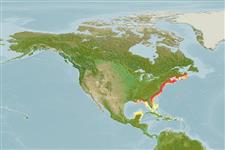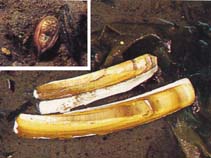Ensis directus Conrad, 1843
American jack knife clam| Native range | All suitable habitat | Point map | Year 2050 |

|
| This map was computer-generated and has not yet been reviewed. |
| Ensis directus AquaMaps Data sources: GBIF OBIS |
Классификация / Names народные названия | синонимы | CoL | ITIS | WoRMS
Bivalvia | Adapedonta | Pharidae
Environment: milieu / climate zone / пределы глубины / distribution range экология
; солоноватоводный; пределы глубины 0 - 73 m (ссылка 104365). Temperate, preferred 12°C (ссылка 107945); 46°N - 18°N, 91°W - 59°W
Distribution страны | регионы FAO | Ecosystems | места находок | интродукции
Western Atlantic Ocean: from Nova Scotia, Canada to Florida and southern Gulf of Mexico to Campeche, Mexico. Introduced in the Northeast Atlantic from UK (England and Wales), the North Sea to southern Norway and southern Baltic Sea to Spain in the southern Bay of Biscay. Tropical to temperate.
Length at first maturity / Size / Weight / Возраст
половая зрелость: Lm ? range ? - ? cm Max length : 26.0 cm TL самец/пол неопределен; (ссылка 7726)
Life cycle and mating behavior половая зрелость | размножение | нерест | Eggs | Fecundity | Larvae
Основная ссылка
ссылки | координатор | соавторы
Harvey-Clark, C. 1997 Eastern tidepool and reef: north-central Atlantic marinelife guide. Hancock House Publishers, 64pp. (ссылка 7726)
Статус Красного Списка МСОП
(ссылка 130435: Version 2025-1)
Статус СИТЕС (ссылка 108899)
CMS (ссылка 116361)
Угроза для людей
Использование человеком
рыболовство: коммерческий
FAO - рыболовство: landings | FishSource | Sea Around Us
инструменты
дополнительная информация
ресурсы в Интернет
BHL | BOLD Systems | CISTI | DiscoverLife | FAO(рыболовство: ; publication : search) | Fishipedia | GenBank (Геном, Нуклеотид) | GloBI | Gomexsi | Google Books | Google Scholar | Google | PubMed | Tree of Life | Wikipedia (Вперёд, поиск) | Zoological Record



